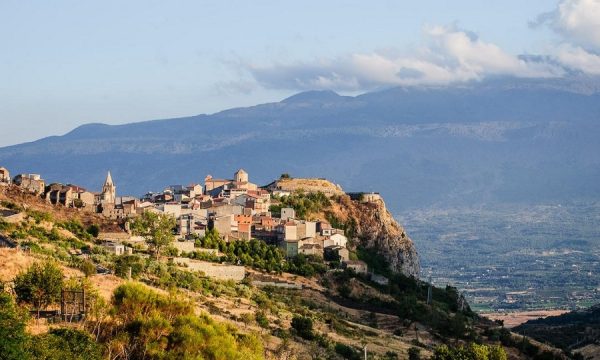Mount Etna is a spectacular volcano to explore in all its forms and in every corner. But there are places from which Etna can be admired in its full majesty, becoming a unique and unforgettable panorama. Among the villages that surround the volcano and admire it from a distance there is Roccella Veldemone (Messina). And it’s not just there now, but it has always been.
The valley around the large rocky mountain’s top – from which the town takes its name – was inhabited since prehistoric times. And, with certain evidence, from the Greek-Roman era. Roccella has changed its name dozens of times (Auricella, Rocchella, Roccella Mediterranea, Roccella di Randazzo …) but it has come to our days bringing with it a memory of the Norman age.
Roccella of Val Demenna
Immediately after the Arab domination, when the Christians reconquered Sicily, the territory remained politically divided into three main regions. The Arab sultans had designed them and they were three “valli”: Vallum of Mazara (west), Vallum of Noto (south-east) and Vallum of Demenna (north-east). The Val of Demenna took its name from an area, perhaps a city, which developed and then disappeared before the arrival of the Romans on the island. It must have been located not far from the current Alcara Li Fusi, in today’s Messina area.
 photo by giuseppe tropea MEDIOEVOSICILIA EU
photo by giuseppe tropea MEDIOEVOSICILIA EU
This “vallum” was the first to appear on Arab maps first, then on Byzantine ones. When the Normans arrived, they found the highest number of Christian refugees in the Val of Demenna – in the meantime called Val Demòna or Valdemone. So from here began the reconquest of the entire island. At that time, Roccella did not yet exist but there was a village gathered around the monastery of St Nicolò di Pillera. That would be the first core of the town.
Roccella, the Norman fief
The presence of a convent favoured the arrival of noble lords interested in the surrounding land. And soon a castle was also built near the village, ensuring its safety and encouraging the population to settle there. The large rocky top overlooking the town was also an excellent sighting and defense point, which is why the population moved higher and higher on the mountain.
Roccella Veldemone then became a baronial fiefdom first and, in the 17th century, the seat of a marquisate. The family of the Spadafora marquises left an important and eternal imprint in the area, which you can still read today in some coats of arms and in the names of the neighbourhoods. Today Roccella is a town that has preserved its medieval aspect intact. Despite the typical depopulation of many inland villages, today it is recovering. Its relative proximity to places such as Solicchiata, Malvagna, Linguaglossa – the routes of wine! – is encouraging a new interesting tourism. Which obviously also passes from Mount Etna.
From Etna to Roccella
If you are in North Etna, on the ski slopes of Piano Provenzana or in the pine woods of Ragabo, you are already in the territory of Linguaglossa. You could put Roccella Valdemone into an itinerary based on panoramas and … wine!
The beautiful wineries that cover the area between Linguaglossa and Santa Domenica Vittoria will be stages of a path that, deviating at a certain point, will lead you towards Mojo Alcantara and Malvagna. From Malvagna, Roccella Veldemone is just 11 km away, 20 minutes by car. The territory is full of curves, so it’s not easy. But every curve reveals a spectacular view! And finally there is Roccella, the town gathered around its mountain.
Here you can visit: the beautiful main church of St. Nicola di Bari. Fourteenth-century origin, as shown by the interiors still in Romanesque style, it was rebuilt in the 17th century with the addition of baroque elements. The most evident is the façade, with a mixture of white stone and lava stone, flanked by a bell tower entirely built with lava. The church of St. Maria dell’Udienza stands out for its Arabic-style bell tower that hides a mystery … a room full of human bones, sealed between the tower itself and the sacristy! The fourteenth-century St Michael Archangel is one of the oldest testimonies of Roccella’s medieval architecture.
The old town, although small, is dotted with baronial palaces dating back between 1500s and 1800s. On top of the rocky mountain’s top, on the other hand, stands the church of Calvario. Here, the prisoners condemned to death received the last blessing before being hanged at the foot of the rock.
In the surroundings of Roccella …
In the surroundings of Roccella you can explore various naturalistic areas of incredible beauty. The beauty, however, is linked to the same difficulty of access, due to the high mountains and narrow gorges. The Argimusco Plateau is easily accessible, but routes such as the Palazzolo Rocks or the Angara di Piristeri gorges, carved by the Licopitru river, require a more serious commitment. Hiking enthusiasts, however, will also love to arrive at Rocca Pizzicata (where you can admire prehistoric caves) or at Malabotta wood. Finally, Mount Etna is always part of the panorama that can be seen from every curve and from every corner of the Roccella area.
How to get there
To reach Roccella Veldemone we suggest you to follow the Messina-Catania A18 motorway, exit at Giardini Naxos. Then follow the signs for Francavilla and Mojo Alcantara. From there, you will then find the signs for Roccella. Those who are already on Etna will descend from Linguaglossa, following the State Street 120, then towards Mojo Alcantara on the provincial roads SP 64 and SP 2.
The nearest airport is Catania Fontanarossa. The nearest railway station is Taormina-Giardini. (THE PHOTO ABOVE THE TITLE, COURTESY OF: F.A.I, Fondo Ambiente Italiano)